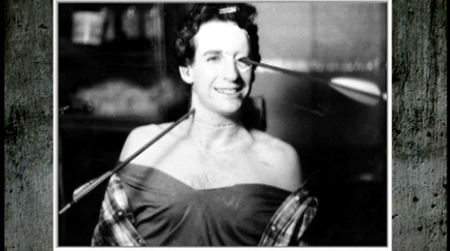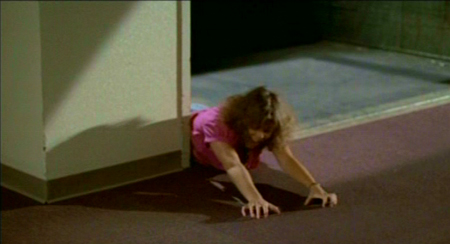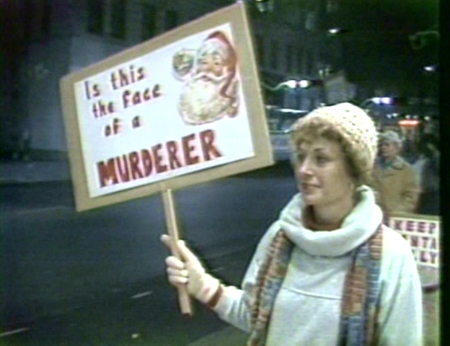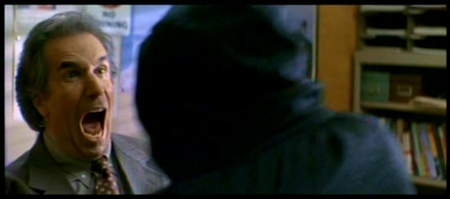BUY IT AT AMAZON: CLICK HERE
STUDIO: Thinkfilm
MSRP: $24.98
RATED: NR
RUNNING TIME: 88 minutes
SPECIAL FEATURES:
• Commentary w/ filmmakers
• Extended interviews
• Trivia game
• Introduction by author Adam Rockoff
The Pitch
"A
brief history of murdered sluts."
The Humans
Interview
appearances by Wes Craven, Tom Savini, John Carpenter, Sean Cunningham, Amy
Holden Jones, Rob Zombie, and many more.
The Nutshell
When a
culture produces a wealth of a certain genre of entertainment, there must be
something to it, the sort of thing that gets sociologists up in the middle of
night. Over an hour-and-a-half, slasher fans and filmmakers offer up their
comments on the mythology of the unstoppable killer, the punishments of teenagers,
and the births of several icons that have already taken their places in
cinematic history.
The Lowdown
It’s a
self-contradicting phrase, but horror fascinates. The genre has the capacity to
inflame the protests of individuals, earn the voting dollars of millions of
moviegoers, inform an audience, or repulse one. It’s a genre that contains so
many contrasts that it’s near impossible not to fall on one side of an opinion
regarding it. Are the films misogynistic or feminist? Do they work as cautionary
tales, or are they themselves the pit of moral depravity that such tales warn
against? All these topics and more are handled with skill in Going
to Pieces.

Mr. Tell is ready for his close-up.
Because
the horror genre contains so many subgenres, the documentary focuses on the
slasher films. It begins its tracing of the lineage of such stories with the
Theater de Grand Guignol, which ran macabre shows and entertainments for around
sixty years, starting at the tail end of the nineteenth century. The historical
reference works as an early bit of support for one of the film’s theses, that
being that the slasher genre is neither new nor easily dismissed; it follows a
literary tradition. "Any time a story terrifies us," notes director
Amy Holden Jones, "it becomes history."
Amongst
the survey of the genre’s own history, arguments such as these keep recurring,
defending horror as a mode of storytelling worth more respect than it
traditionally attracts, at least as far as cinematic entries are concerned. This
subtext, present in many of the interview segments, never comes across as the
whining of maligned artists, though; the explicit arguments present are
delivered with candor and eloquence.

This lady was up against Deep Roy for that one episode of The X-Files.
You know which one. You haven’t stopped shivering, yet.
The
course of the film tracks through some of the founding fathers of the genre: Halloween,
Friday
the 13th, and Prom Night — with nods back to
Hitchcock — before documenting the explosion of copycat filmmakers, and the
saturation of the market with gorey offerings. Strangely, though the glut
possessed very few films of the quality of Halloween or even Black
Christmas, that period in the slasher movie’s life is responsible for much
of its recognition. The films in the formula were ever-present, and thus
demanded the response of critics and casual viewers alike. Gene Siskel and
Roger Ebert recorded arguments against the genre; segments of that interview
are included in Going to Pieces. Through an unlucky birth, the slasher films
found their legitimacy.
After
noting the gradual dying of these baby slasher boomers, the documentary
proceeds into a number of rapid fire topics that dig at the nature of horror,
the sociological and cultural implications of the genre, and the psychological
states of its proponents. For any viewer already familiar with the history of
80s horror cinema, this ought to be the most interesting part of the film.
Unfortunately, it receives comparatively little air time, and subjects whose
titles get my mouth watering — such as "
the Boogeyman?" — are fired and forgotten about with no more than a
minute devoted to each. The result is a final third that feels more like a clip
show than a serious discussion of the genre.

No, but you watch the hell out for those elves.
Before
devolving that far, though, Going to Pieces raises a point of
interest that I want to spend some time considering, because it’s a worthy one.
There are two conceivable draws to slasher films that are mutually exclusive.
Some audiences go because they enjoy the familiarity of the formula. They like
for the virgin to survive, the slut to be offed. It’s got to be like some sort
of Cassandra complex; the audience knows what’s going to happen, and that
knowledge makes the tension all the sweeter. On the other side of the aisle,
there are the audiences who started going to slasher films because they wanted
to be shocked, surprised, and scared;
they wanted their boundaries pushed, to see new and exciting deaths and
creative scares. No viewer is fully distinct on one preference or the other, but
it sparks something curious in me that the films in the genre measurably
diverge.
Going to Pieces does an admirable job of
providing serious presentation for a genre that is often misunderstood to be
all about the viscera, and involve little of the brains, except for those
exploding out the back of a zombie’s head. It contains more content than it has
time to significantly discuss, but I won’t fault the filmmakers for merely
introducing these noteworthy topics, especially since they can be intelligently
argued by fans and non-fans alike. As a social presence and a cinematic
tradition, slasher films have made their undeniable history. They deserve much
more of this type of respectful analysis.

The best NO-face in horror.
The Package
The
bonuses include an excellent commentary with producers Rachel Belofsky and Rudy
Scalese, and editor Michael Bohusz (Bohusz feature!) in which the filmmakers
expand upon the anecdotes and interviews that make up the majority of their
movie. A number of good insights are to be found, here.
There’s
also a brief, textual introduction by author Adam Rockoff, who wrote the
non-fiction book that inspired the filmmakers: Going to Pieces: The Rise and
Fall of the Slasher Film.
Aside
from those, there are a few expanded interview segments, and a fun little
trivia game for the horror fiend in your house.
7.5 out of 10
